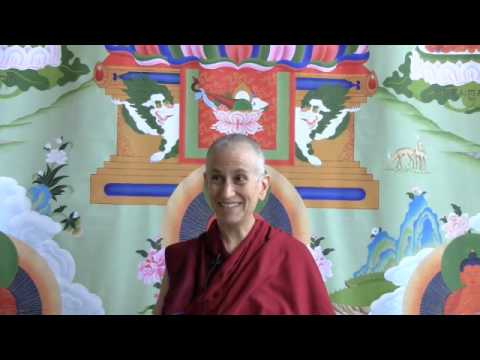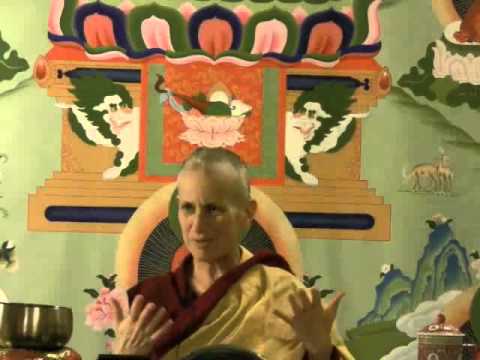How to see Tara
Part of a series of Bodhisattva's Breakfast Corner talks given during the Green Tara Winter Retreat from December 2009 to March 2010.
- It is incorrect to project human qualities on Tara or see her as a theistic god
- When we pray or make requests, it is a psychological method to inspire our practice
Green Tara Retreat 009: How to see Tara (download)
Regarding some questions that have been asked, somebody is saying that I recommended that we don’t anthropomorphize Tara, but some expressions in the sadhana make her confused about that. For example, when we say, “Mother Tara,” or when we say, “Tara, please take care of me,” and things like that. What I meant by anthropomorphize is—and there’s a few things going on here. If we make Tara into a person, she just happens to be green instead of whatever color human beings usually are (which is a wide variety but we don’t come across too many green ones). Then she’s just like everybody else in my life. She rejects me. She criticizes me. She abandons me. Whatever our thing is, the usual thing that we project onto people and relate to them how they react to us, then we just do that with Tara too. That doesn’t work, does it? We make Tara into some other person, make her like everybody else in our life that we’ve projected this thing onto, and then relate to her that way. That doesn’t work in our meditation at all.
On the other hand, if we anthropomorphize Tara and make her into a god (like a theistic god), then when we say, “Tara please protect me.” We expect her to come down and swish us up and take us away on her magic carpet to the Potala pure land. That’s not going to work either in our meditation. That kind of idea doesn’t really fit into Buddhism. That’s one of the reasons I say not to anthropomorphize.
When we say in some of the request prayers, “Tara, please inspire me,” or, “Please bless me to realize this or that,” what we’re doing is a very skillful psychological method (because we usually project everything outside). We’re relating to Tara as the future buddha that we’re going to be. We’re requesting inspiration from that future buddha to integrate into us right now so we gain those realizations. Or, we look at Tara as somebody who is already a buddha and we’re asking for her encouragement, her inspiration, to develop those realizations. We’re not asking that she come and put the realizations in our mind, because that’s impossible. There’s one verse that says that the Buddha can’t pour his realizations into us like you pour water. He can’t transfer them into you like you would transfer money from one account to another. (I don’t think that [last] example was in the scriptures.) But it’s not like that. How does the Buddha “give us realizations”? It’s by teaching us the Dharma, and instructing us on how to meditate on that and integrate those teachings into our own mind. That’s what we’re actually saying to ourselves when we’re requesting Tara’s help.
Even in a situation when we’re having a lot of suffering, if we call out to Tara for help, if we have the karma maybe Tara could intervene and change the external situation. Usually what we’re asking for, what we’re requesting is, “Tara, please help me to see the mental tools that I need to call to the front of my practice right now, so that I can deal with this unfortunate situation in a way that’s going to transform it into the Dharma path to enlightenment.” That’s what we’re really saying when we say, “Tara please help me. I’m terminally ill, please help me.” What we’re really saying is give me the tools to transform this experience into the Dharma path. If I’ve created the karma in the past to be able to be cured from this disease, help that karma to ripen. But we can’t ask Tara to do something that we haven’t created the karma to have happen. If we ask, “Please cure me,” but we haven’t accumulated the karma to be cured, that’s not going to happen. If we really call out and say, “Please help me to see the Dharma methods to apply so that my mind is happy and peaceful,” for sure Tara can do that.
By our requesting in that way, that is our making our mind open and receptive so that when Tara gives us some instruction, we will actually listen to it and heed it and pay attention to it. We usually think that we’re very open and receptive vessels. If we look at how often we actually apply the Dharma teachings that our teacher tells us (either in an individual manner or in a group setting), how often we actually follow the instructions, then we’ll see that there’s some improvement on our part that needs to be made. So making that request is saying to ourselves, “I need to improve on my part and really try and follow the instructions.” Lots of times we go to our teacher and we say, “I have this problem, what do I do?” We get instructions and then we don’t do it. We kind of say, “Oh well, that sounds good but my teacher doesn’t really understand what my problem is,” so we don’t even try the instructions. Or we say, “Oh, that would be good, but later on I’ll do that.” You know how it is. We do this all the time. So the point of making these request prayers is to open our minds so that we really take the instructions seriously and try to apply them, whether they’re given individually or in a group situation—to use the tools in our toolbox.
Venerable Thubten Chodron
Venerable Chodron emphasizes the practical application of Buddha’s teachings in our daily lives and is especially skilled at explaining them in ways easily understood and practiced by Westerners. She is well known for her warm, humorous, and lucid teachings. She was ordained as a Buddhist nun in 1977 by Kyabje Ling Rinpoche in Dharamsala, India, and in 1986 she received bhikshuni (full) ordination in Taiwan. Read her full bio.


